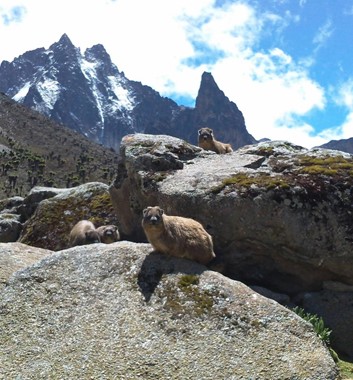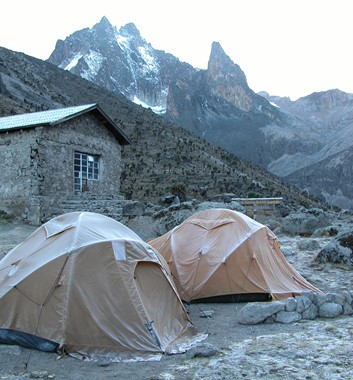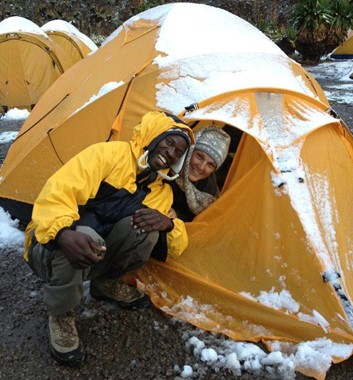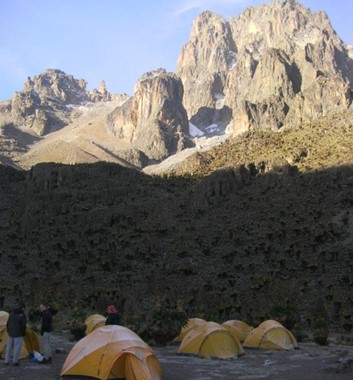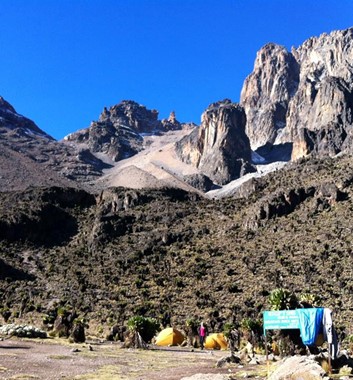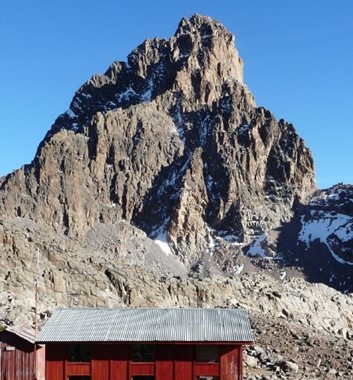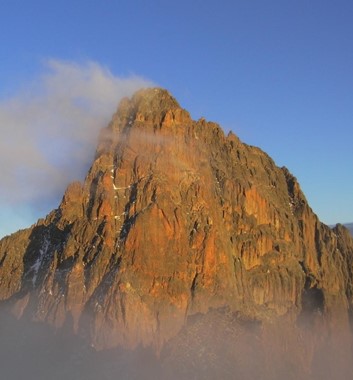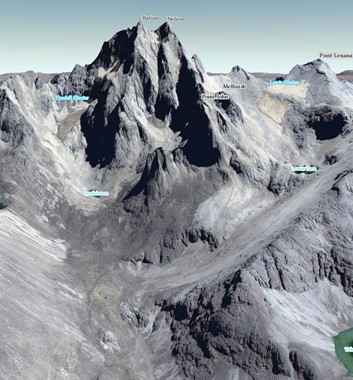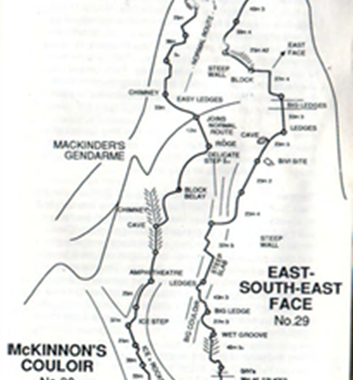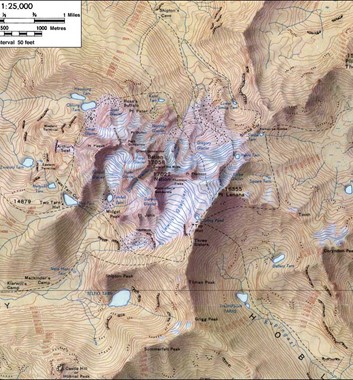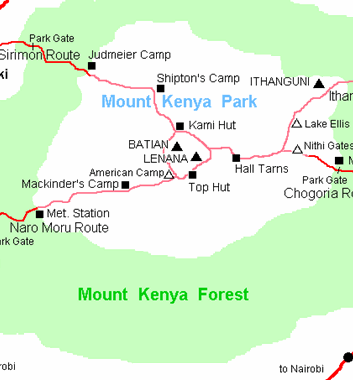Overview
We offer guided ascents of the South East Face standard route to the summit of Nelion (5188m), the second highest of Mount Kenya and only around 10m lower than the highest peak of Batian. After the trek in and acclimitisation on the Naro Moru or Sirimon route, the technical climb is normally completed in one long day as a series of 18 - 20 pitches, although it is possible to bivouac on the summit in the Howell Hut and descend the next day.
The best months to summit Nelion are generally December - March when the sun will be on the route and it will be relatively dry, although it's wise to always anticipate and prepare for rain, snow and wind. Always take a lightweight warm sleeping bag and bivi bag with snacks just in case.
The crux of the climb is UIAA IV- or a UK hard severe or American 5.5, although the altitude may make it seem harder than this. Most passages are II-III or Diff/V Diff. De Graaf's variation is commonly used by guides now and is the crux move, it's slightly longer but less exposed than the Rickety Cracks, and it has excellent protection with a bolt on the upper part of the pitch where there is an awkward step out.
The route is about 400 vertical metres, and doesn't follow a direct line; route finding can be tricky in low visibility. A lot of the route is roped-up steep scrambling and running belays on steep rock, with the longest pitches around 50- 60 metres. A strong efficient climber who is well acclimatized can move swiftly and reach the summit in about eight hours. Although the guide will lead, it's important to have good belay skills when seconding and be familiar with all types of belay devices.
The descent is a series of abseils following a slightly different line to the ascent and using bolted rings in the rock. It is important to be competent in abseiling unassisted (without a top line) and be completely familiar with using descenders. It is possible to descend with 8 abseils but guided climbs commonly take up to thirteen.
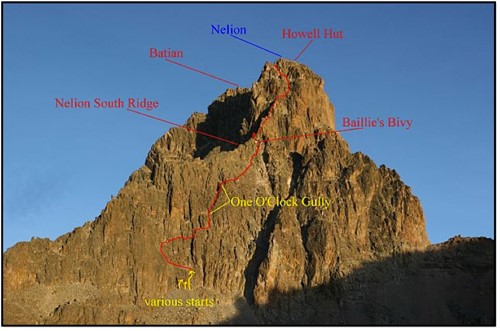
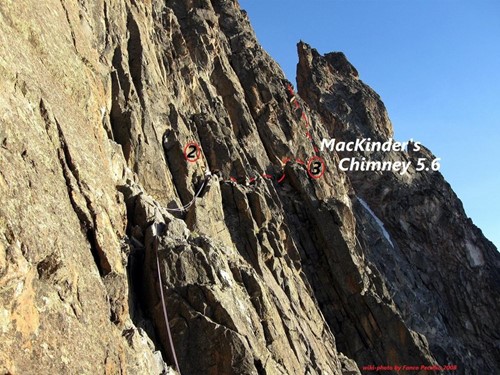
Approach to MacKinders Chimney (photo courtesy Mountain Project)
The Gates of Mist - crossing from Nelion to Batian
For strong climbers t is possible to cross the 'Gates of Mist' from Nelion Peak to Batian Peak but climbers must be prepared to bivouac in Howell's Hut; also the route across (a down climb followed by a short steep climb up can often be full of snow, especially around December time). The route is quite demanding, especially at altitude and being already tired and with the pressure of a descent before dark ahead of you. Best only attempted in great conditions and with plenty of time.
When to climb Mt Kenya
Rain and snow can be experienced any time of the year on Mount Kenya, with maximum rainfall over the forest and on the south east of the mountain between March and May and slightly less so from October to December. The driest time on the south side is late December to February with long stable days giving typically excellent conditions for the climb, but still expect snow up high.
The south side of the mountain gets the most sunshine from December to March with the rock in condition and less likelihood of ice, but do still expect patches in the gullies. Conversely June to October is best for south facing ice climbing or the north facing rock climb on Batian.
Temperatures vary, obviously getting colder with altitude and depending on time of day. Expect 5 to 15°C during the day, with night time temperatures well below freezing and frost around the 3000 metre mark.
Route description of Nelion SE Face
To trek to the third peak of Point Lenana on Mount Kenya is accessible to anyone with good basic fitness. Four days hike on a variety of terrain taking in the beautiful surroundings and unique flora and fauna is a lovely experience, and you can camp or stay in huts on the way. Initially on a dirt track through bamboo forest and then forest and onto heathland as you gain height. Plenty of wildlife to see including colobus monkey, elephant and buffalo (round the camps), bushbuck, Sykes monkey and rock and tree hyrax. The Teleki valley has wonderful giant lobelia and, tree and cabbage groundsels and gladioli.
The summit day begins from Austrian Hut which is about a 45 minute hike across the Lewis Glacier to the base of the route at 4800m. This used to need crampons and an axe but nowadays the reduction of the glacier means you can manage in boots and being careful of mini mud slides and moving scree, especially coming back down potentially in the dark and exhausted.
The climb of Nelion takes between 6 and 9 hours to complete, plus an additional 1-2 hours if the crossing of the gate of the mists to Batian is made. The route is usually tackled in 15 to 20 pitches, varying from scramble to UIAA IV+ (UK VDiff to Severe, US 5.5) but with most being at around UIAA II (UK Diff, US 5.3). Technically it is not especially demanding for a seasoned rock climber but the length of the route and the altitude make for a challenging day. It's important to climb consistently and competently to get it all done in the day.
Objective hazards include rockfall, long runouts, exposure from the weather, time limitations due to the length of the day and route finding.
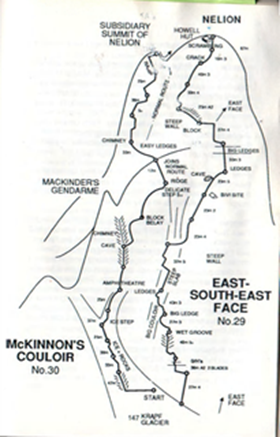
Route map of Nelion (photo courtesy The Crag)
The rock is Nepheline Syenite which is similar to granite and can be quite abrasive in places. The rock is quite 'blocky' with large weathered fissures running vertically and horizontally usually offering lots of obvious holds and good friction. However, there is some loose rock especially in the bottom of some of the couloirs and notches.
Most of the belay points are made with slings or tat around rock spikes and boulders but there are a few pitons in place along the way too. Protection between belays is traditional with nuts & cams. The descent uses bolted rings.
Summarizing the factors to take into consideration for this route:
It's a long climb and a long day averaging 9 hours for the complete climb and abseil. A 1:2 guide-client team will inevitably take longer. Competence with the grade and at altitude over many hours, handling belay change-overs and abseils efficiently all together make up the biggest challenge, and it's important to come prepared for a bivouac on the summit.
There are two potential summit days, but cold and bad weather clearly have a significant role in decision making. There is a potential third summit day if the walk out to the gate is condensed into a single day. The walk down is a long way, so please don't underestimate this.
Also the remote location means there are few if any rescue facilities available and any situation would have to be self-managed to a safe point where the guide could quickly descend to get help. The Austrian Hut is just below the start of the route and there is a Ranger station a few hours below in the Teleki Valley but phone signals are not reliable. Therefore the implications of an accident on the climb would be severe.
Route-finding on the ascent is not always obvious and the descent route does not follow the ascent route; in low visibility due to mist or just getting dark as time runs out, it would be easy to go off route or spend time looking for well known anchor points or rappel rings. It is important to get a prompt start in the morning, keep an eye on the time and be prepared to descend especially if you are not prepared for a bivouac.
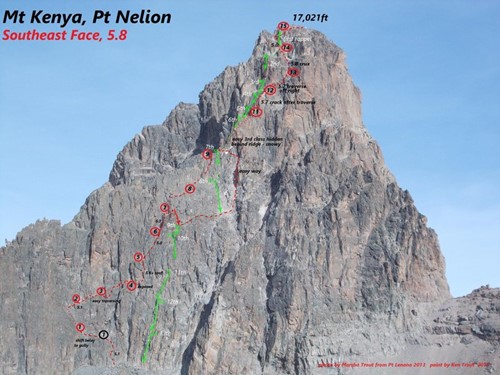
Brief history of the mountain
Mount Kenya is an extinct volcano created by tectonic disturbance of the Great Rift Valley. Over the course of the last couple of million years it has been eroded down by glaciers and the elements to around two thirds of its original height. It has a circular massif with valleys and ridges emanating from the central summit peaks. The peaks are the remains of the volcanic plug where the magma left in the vent solidified underground. This hard Nepheline Syenite and Phonolite rock is much harder than the lavas around and as such has eroded much more slowly, leaving the summit spires.
Mount Kenya is also the source of the name of the country of Kenya. In British colonial times it was only the mountain that was known as 'Kenya'. Local tribes all had their own names for the peak, some of them resembling the word 'Kenya' phonetically. Traditionally these peoples saw the mountain as the seat of their gods on earth, commonly known as Ngai. Mount Kenya is therefore bound up with the modern and traditional culture of the area.
Nelion was first climbed by Eric Shipton and Percy Harris on 6 January 1929 and they crossed the gate of the mists to summit Batian at the same time.
The Mountain Club of Kenya has a close historical association with the mountain, notably through the lives of two climbers Ian Howell and Iain Allen. Both men pioneered many climbing routes in Kenya but Ian Howell is perhaps best remembered for a remarkable feat of endurance when he single handedly built the Howell Hut on the summit of Nelion in a few weeks in 1970, making 13 solo ascents carrying the materials and equipment. He was a climbing tour de force who sadly died in 2018. Iain Allen is the author of the most well known guide to climbing the mountain and is the leading authority on climbing it, with 40 years of experience developing the routes on Mt Kenya and in Hell's Gate National Park. Their combined influence on climbing on Mount Kenya and throughout the country cannot be underestimated.
Suggested itinerary
The rainy seasons in Kenya are usually April, May and November. Therefore the normal times for a climb are December to February with March also being an option. If you would like to climb in the July-September season then please see our page for climbs of Batian via the North Face Standard Route.
The following is a suggested itinerary to give a great overview of the mountain in general and also to promote good acclimitisation ahead of the climb.
| Day | Summary |
| 1 | Transfer from Naro Moru town to the Sirimon National Park Gate and trek to Old Moses Camp |
| 2 | Trek from Old Moses Camp to Shipton's Camp |
| 3 | Acclimatisation hikes / R&R and second night at Shipton's Camp |
| 4 | Trek Shipton's - Point Lenana - Austrian Hut |
| 5 | Climb Day: Austrian Hut - Nelion Peak - Austrian Hut |
| 6 | 2nd Climb Day |
| 7 | Trek from Austrian Hut to Lake Ellis and on to Nithi Falls |
| 8 | Trek from Nithi Falls to Meru Bandas for 4x4 transfer to Chogoria town and transfer to Embu |
You are welcome to adjust the itinerary and add a safari, please do discuss options. Ol Pejeta Conservancy is very close to Naro Moru (or a reasonably short drive from Embu) and is a great location for a safari.
When to climb Mt Kenya
Rain and snow can be experienced any time of the year on Mount Kenya, with maximum rainfall over the forest and on the south east of the mountain between March and May and slightly less so from October to December. The driest time is late December to February but still expect snow potentially up high, although long stable days are typically excellent conditions for the climb.
Generally the morning time is best for climbing with convection rainfall occurring mid afternoon. The south facing side of the mountain gets the most sunshine from December to March so this is an excellent time to climb this route with the rock in condition and less likelihood of ice, but do still expect patches in the gullies. Conversely June to October is best for the north facing rock climb on Batian and south facing ice climbing.
Temperatures vary substantially, obviously getting colder with altitude and depending on time of day. Expect 5 to 15°C during the day, with night time temperatures well below freezing and frost around the 3000 metre mark.
Clothing and kit
Trekking clothes to cover the warm humid forests up to the snowline, good hiking boots and a warm lightweight sleeping bag. We provide foam mattresses but bring your own inflatable mat (e.g thermarest or exped) for extra insulation and to use for a potential bivi. Don't forget headtorch and spare batteries, especially since the climb begins and often ends in the dark. Water bottle and flask and snacks are vital, along with suncream and first aid kit.
Wear layers of warm clothes for the summit days and don't forget waterproofs and windbreakers. A quality belay jacket with hood is important, and leather belay gloves as well as thermal gloves.
For the climb bring your own harness, helmet, a medium rack of sprung cams, hexes and nuts along with 2 slings (long and short), a few prussiks, several screwgate karabiners, a descending device and belay device of your choice, some quickdraws and a cowtail. Crampons (or mini spikes) and walking axe are optional nowadays because the Lewis Glacier has retreated so much but poles are very useful for the trekking.
Safety point about using daisy chains - if you need to make your own personal anchor system for security at belay and rappelling points please note that daisy chains should be clipped end to end for optimal use, and adjustable daisy chains are not recommended as primary anchor attachment.
Group gear will include 2 single 60m ropes, and a collection of climbing protection aids (nuts, cams etc), slings, prussiks and quickdraws but it's important you arrive self-sufficient and not reliant on the guide's equipment. You can hire some gear at the base of the mountain but we cannot guarantee the quality.
Bivouac pack
On summit day take a small sack with a lightweight sleeping bag, bivi bag, lightweight mat if possible, snacks and food, flask and water bottle, belay jacket and space for a spare base layer, spare hat/gloves etc. Take spare batteries for headtorch, small first aid kit, sun cream, quality sunglasses and if there is a space a micro stove or jetboil.
Footwear
Take a comfortable pair of hiking boots for the trek and a pair of stiffer mountain boots which can take crampons or spikes for crossing the glacier and doing the climb. The sole should be stiff but allow some 'feel' for the rock. Rock shoes are an option but probably best for the warm days and for people moving fast and very efficiently. Otherwise they are likely to get wet and your feet will get very cold, so it's best to keep your options open and take something warm for your feet whatever the case.
Other information pages which might be useful:
Mount Kenya Routes - a full description of all the trekking routes and options for climbing the peaks of this mountain.
Mount Kenya Trek options - includes information about add-ons to the trip, and costs for local accommodation and transfers.
Trekking kit list includes more information about clothing and a packing list for Mt Kenya.
Climb Mount Kenya displays all of our trips on the mountain including Batian Peak.
Useful Books and Maps, Videos and Links
Guide to Mount Kenya and Kilimanjaro by Iain Allen, Mt Club of Kenya 1990
Kilimanjaro & Mt Kenya by Cameron Burns, 1998
Mt Kenya Map and Guide by Mark Savage and Andrew Wielochowski 1998
Note: visitors to Kenya can visit the MCK bookshop or order online the MCK publications.
Summit Post route description
Mountain Project route description
The Crag route description
Mountain Club of Kenya rock climbing tips and general information
CNN feature on climbing in Kenya featuring Iain Allen
Dates & Bookings
Cost
Mount Kenya Nelion Peak cost £2295.00
Price is per person for group of two, the single person supplement is currently £400.00. Full details of any extras that we can provide can be found under 'Mount Kenya optional extra costs'.
INCLUDES
- Transport from Naro Moru town to Sirimon Gate and from Chogoria Gate to Embu
- Transfer of your travel clothes and bags to Embu town
- Park fees
- Camping fees for 4 nights) and Austrian hut fees for 3 nights)
- All meals on the mountain
- Park rescue fees (Ranger assistance in the event of an accident)
- Park certified trek guide for the trek
- Climbing guide for the summit days only* (maximum ratio 1:2)
- Porters and cook
- Group equipment - tents, cooking kit
- Climbing ropes and group climbing protection
* The climbing guide will not be with you on the trek in, he normally is either already at the Austrian Hut or at another camp and meets you at Austrian Hut in time for the summit day. The trekking guide normally keeps in touch with the climbing guide to agree when to meet up, depending on weather.
EXCLUDES
- International airfare to Nairobi Airport
- Transfer to Naro Moru at the start of the trip*
- Kenyan Visa
- Vaccinations and malaria tablets
- Personal expenses
- Travel insurance **
- Personal Climbing Gear
- Upgrade to Mountain Hut accommodation
- Tips
* The itinerary starts at Naro Moru but we can provide transfers from Nairobi and accommodation in Nairobi and in Naro Moru if you wish. Similarly the itinerary ends in Embu and we can provide transfers back to Nairobi or any additions such as safaris. There are some options available when you book, or contact us for a bespoke package.
**Please note that you will need insurance in place to cover trekking to 4985m and technical climbing to 5199m including search, rescue and helicopter evacuation. Please check out specialist providers such as the BMC.
Photos
Extras

Duffle bag
These duffles are waterproof with a top zip, side handles and rucksack straps. They come in two sizes: 90 or 120 litres.

3 season sleeping bag
A good quality 3 season synthetic mummy shaped bag rated to a low of -12°C and a comfort rating of -5°C. Comes with a liner.

Trekking poles
A pair of adjustable trekking poles.

Mountain gloves
Mountain glove with outer shell and fleece lining. Windproof and waterproof. Available in medium and large.

Fleece Gloves
Polar fleece gloves made of thermal fleece with a grip palm and elasticated wrist.

Gaiters
Waterproof nylon gaiters with velcro closure, elasticated top rear drawcord and adjustable underboot strap.

Flask
500ml stainless steel flask for hot drinks. Screw lid doubles as a drinking cup.

Rucksack cover
Protect your rucksack during extreme weather or travel with this tough lightweight protective cover. Two sizes.

Dry bag
Lightweight and waterproof with a rolltop design and ideal for storing kit that needs to be kept separate and dry. Two sizes.

Wildebeest Camp, Nairobi
On the outskirts of Nairobi you can stay in a secluded safari style camp site with tented rooms. Various upgrades include family rooms, deluxe tents and ensuite. Price is per person based on twin share bed and breakfast.
Choose a scheduled date or contact us to set up private dates or a bespoke itinerary. The minimum deposit is £100.00 and the balance is due four weeks before travel.
- Duration 8 days
- Numbers 1 - 3
- Altitude 5188m
- Grade VDiff, Severe
- Route SE Face


